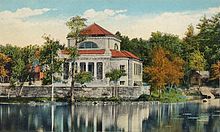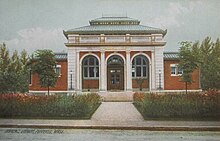Ernest Flagg | |
|---|---|
 | |
| Born | February 6, 1857 |
| Died | April 10, 1947 (aged 90) New York City |
| Nationality | American |
| Alma mater | École des Beaux-Arts |
| Occupation | Architect |
| Spouse |
Margaret E. Bonnell (m. 1899) |
| Children | Betsey Flagg Melcher |
| Parent(s) | Amelia Louisa Hart Jared Bradley Flagg |
| Buildings | Scribner Building Corcoran Gallery of Art Singer Building Charles Scribner's Sons Building Singer Castle |
| Projects | United States Naval Academy |


Ernest Flagg (February 6, 1857 – April 10, 1947) was a noted American architect in the Beaux-Arts style. He was also an advocate for urban reform and architecture's social responsibility.[1]
Early life and education
Flagg was born in Brooklyn, New York. His father Jared Bradley Flagg was an Episcopal priest and a notable painter.[2][3] Ernest left school at 15 to work as an office boy on Wall Street. After working with his father and brothers in real estate for a few years, he designed duplex apartment plans in 1880 with the architect Philip Gengembre Hubert, for the co-operative apartment buildings Hubert was known for.
Cornelius Vanderbilt II, Flagg's cousin through his marriage to Alice Claypoole Gwynne,[4] was impressed by Flagg's work and sent him to study at the École des Beaux-Arts in Paris from 1889–1891, under his patronage.
Professional career
In 1891, Flagg began his architectural practice in New York, greatly influenced by his knowledge of the French ideas of architectural design, such as structural rationalism.
During this time he joined with John Prentiss Benson to create Flagg & Benson, which later became Flagg, Benson & Brockway with the addition of Albert Leverett Brockway. FB&B designed St. Luke's Hospital in New York City.[5]
In 1894, he established the architectural firm of Flagg & Chambers with Walter B. Chambers, whom he met in Paris. Usually, Flagg alone credited for some of the work he and Chambers worked on together, such as the Corcoran Gallery of Art.
Louisa Flagg Scribner, Flagg's sister, was the wife of Charles Scribner II. Through this familial connection, Flagg designed six structures located in Manhattan for the publishing family.[6]
His contributions to zoning and height regulations were essential to New York's first laws governing this aspect of the city's architecture. Flagg argued in favor of zoning laws which would regulate the height and setback of buildings, to allow light and air to reach the streets below them.[7] He was a president of the New York Society of Beaux-Arts Architects. A small collection of Flagg's personal and professional papers is held in the Department of Drawings & Archives at Avery Architectural and Fine Arts Library at Columbia University.
Personal life
Ernest Flagg married Margaret E. Bonnell on June 27, 1899 in New York City. They had one daughter, Betsey Flagg, who married John Melcher[8][unreliable source] and become a well-respected small-scale portrait painter.[9]
In 1912, Mr. and Mrs. Ernest Flagg were on their way to a party held by Stowe Phelps, a fellow architect, when their limousine struck and killed a boy (James McNamara) who had suddenly skated in front of the car. The couple drove the boy to the hospital but he died en route.[10]
Projects

- Scribner Building, New York City, 1893
- Unused plan for the Washington State Capitol at Olympia, Washington, 1893[11]
- Pomfret School campus plan, School House and dormitories,[12] 1894, and the school's Clark Memorial Chapel, 1908[13] Pomfret, Connecticut.
- Gov. Samuel J. Tilden Monument, New Lebanon, New York, 1895–1896
- St. Nicholas Skating Rink, 69 West 66th Street, New York – 1896 [14][15]
- St. Luke's Hospital, New York City, 1896
- Mills House No. 1, New York City, 1896
- Mills House No. 2, New York City, 1897
- Corcoran Gallery of Art, Washington, D.C., 1897
- Indian Neck Hall, estate of Frederick Gilbert Bourne, Oakdale, New York, 1897
- Engine Co. No. 33, New York City, 1898
- Ernest Flagg residence, gatehouse and gate, Staten Island, New York, 1900
- Cherokee Apartments, New York City, 1900
- Armenian General Benevolent Union of America, New York City, c. 1900
- Charlesbank Apartments, Boston, Massachusetts, c. 1900, demolished c. 1960
- Sheldon Library (now admissions office), St. Paul's School, Concord, New Hampshire, 1901
- Lawrence Library, Pepperell, Massachusetts, 1901
- Regency Whist Club, New York City, 1904
- The Towers, a "castle" on Dark Island, St. Lawrence Seaway, 1905
- Buildings at the United States Naval Academy, Annapolis, Maryland, including Bancroft Hall (1901–1906), the Naval Academy Chapel (1908), Mahan Hall, Maury Hall, Sampson Hall, and the Superintendent's residence
- "Little" Singer Building, New York City, 1907
- 311 West 43rd Street, New York City (Originally the Charles Scribner's Sons printing plant), 1908
- Singer Building, New York City, 1908, demolished 1968[16]
- Princeton University Press building, Princeton, NJ, 1911
- Charles Scribner Residence, later Polish Delegation to the United Nations, New York City, 1912
- Charles Scribner's Sons Building, New York City, 1913
- Merrill House, Vinegar Hill Historic District, Bloomington, Indiana, 1928[17]
- Celtic Park apartments, Queens, New York, 1930[18]
- Flagg Court housing development, Brooklyn, New York, 1933–36
- Rufus Arndt House, Wisconsin
Selected writings
- Small Houses: Their Economic Design and Construction (1922)
- Le Naos du Parthenon (1928)
References
- ^ Bacon, Mardges (1986). Ernest Flagg: Beaux-arts Architect and Urban Reformer.
- ^ Flagg, Ernest. Genealogical Notes on the Founding of New England: My Ancestors Part in that Undertaking. Hartford, Conn., 1926, p. 135.
- ^ Flagg, Lucius C.S. Family Records of the Descendants of Gershom Flagg. Quincy, Ill., 1907, pp. 125, 128.
- ^ Eighth Generation Archived 2009-11-23 at the Wayback Machine Descendants of Bartholomew Flegg & Graff, Rebecca Irwin."Genealogy of the Claypoole Family of Philadelphia." Philadelphia, Pa., 1893, pp. 124 & 145.
- ^ Albert L Brockway
- ^ "Streetscapes/The Charles Scribner House; A Quintessential Flagg Building Is Being Restored". https://www.nytimes.com/1994/10/23/realestate/streetscapes-charles-scribner-house-quintessential-flagg-building-being-restored.html.
((cite web)):|access-date=requires|url=(help); External link in|website=|url=(help) - ^ Fire Engine Co. 67 Landmarks Preservation Commission
- ^ Ancestry.com. New York, New York, Marriage Index 1866-1937 [database on-line]. Provo, UT, USA: Ancestry.com Operations, Inc., 2014.
- ^ Betsey Flagg Melcher Luce Foundation Center for American Art.
- ^ "BOY SKATER KILLED BY DINERS' AUTO; Mr. and Mrs. Ernest Flagg's Car Runs Down Lad at Stowe Phelps's Door." New York Times, February 24, 1912.
- ^ Pierce, J. Kingston. "Olympia Capitol — A History of the Building". historylink.org. HistoryLink. Retrieved October 1, 2016.
- ^ "Centerbrook Architects and planners". centerbrook.com. Centerbrook Architects and Planners. Retrieved 20 October 2015.
- ^ "Philadelphia Architects and Buildings". Philadelphiabuildings.org. The Athenaeum of Philadelphia. Retrieved 20 October 2015.
- ^ White, Norval; Willensky, Elliot; Leadon, Fran, AIA Guide to New York City, Oxford University Press, 2010. Cf. p.358.
- ^ "STREETSCAPES: A Skating Rink/Boxing Ring, And a Wild and Crazy Facade", The New York Times, February 6, 2005
- ^ "Bulging Buildings: Cantilevers Make a Comeback". New York Sun. July 3, 2008. Retrieved 2008-07-25.
In 1908, Ernest Flagg designed one of Lower Manhattan's most distinctive skyscrapers for the Singer Manufacturing Company, at Broadway and Liberty Street ...
((cite news)): Cite has empty unknown parameter:|coauthors=(help) - ^ Vinegar Hill Historic District (105-055-77001-77061). City of Bloomington: Bloomington Historic Preservation Commission, n.d. Accessed 2011-01-27.
- ^ Plunz, Richard. A History of Housing in New York City. Columbia University Press, New York: 1990. P. 213-214.
Further reading
- Flagg, Ernest - Genealogical Notes of the Founding of New England: My Ancestors Part in that Undertaking Lockwood & Brainard Co. (1926) ISBN 0-8063-0533-9
- Mardges Bacon, Ernest Flagg: Beaux-Arts Architect and Urban Reformer, MIT Press (1986)
- Paul Malo, "Boldt Castle", Laurentian Press (2001)
- Paul Malo, "Fools' Paradise", Laurentian Press (2003)
External links
- Ernest Flagg architectural records and papers, 1888-1972.Held by the Department of Drawings & Archives, Avery Architectural & Fine Arts Library, Columbia University.
- Ernest Flagg at NYC Architecture
- Ernest Flagg at MIT Press
- Ernest Flagg at Structurae
- Buildings by Ernest Flagg at the Library of Congress's Historic American Buildings Survey database
| International | |
|---|---|
| National | |
| Academics | |
| Artists | |
| People | |
| Other | |